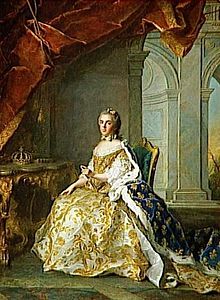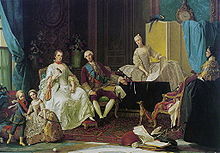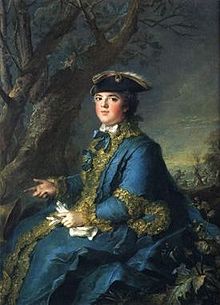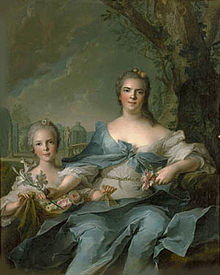- Louise Élisabeth of France
-
Louise Élisabeth 
Louise Élisabeth de France, Duchess of Parma, in court dress, by Jean-Marc Nattier, (posthumous, 1761) Duchess consort of Parma, Piacenza and Guastalla Tenure 18 October 1748 – 6 December 1759 Spouse Philip, Duke of Parma Issue Isabella, Archduchess of Austria
Ferdinand, Duke of Parma
Maria Luisa, Queen of SpainFull name Marie Louise Élisabeth de France House House of Bourbon Father Louis XV of France Mother Maria Leszczyńska Born 14 August 1727
Palace of Versailles, FranceDied 6 December 1759 (aged 32)
Palace of Versailles, FranceBurial Royal Basilica of Saint Denis, Paris, France Signature 
Louise Élisabeth de France[1][2][3] (Marie Louise Élisabeth; 14 August 1727 – 6 December 1759) was the eldest daughter of King Louis XV of France and his Queen consort, Maria Leszczyńska, and the elder twin sister of Anne Henriette de France. As the daughter of the king, she was a Daughter of France (fille de France). She married Infante Philip, younger son of Philip V of Spain, and later became Duchess of Parma. In secondary sources she is referred also as "Louise Élisabeth of France".[4][5]
Contents
Early life
Marie Louise Élisabeth de France and her twin sister Henriette de France were born at the Palace of Versailles on 14 August 1727 to Louis XV of France and his wife, the Polish born queen, Maria Leszczyńska. With her younger twin, she was baptised at Versailles on 27 April 1737. She was known at court as Madame Royale, Madame Première, Madame Élisabeth, and also as Babette within her family circle.
She was said to resemble her father and was his favourite daughter.
She was put in the care of Marie Isabelle de Rohan, duchesse de Tallard.
Élisabeth was raised at Versailles with her twin sister, Henriette, their younger sisters Marie-Louise, Marie Adélaïde, and their brother, the Dauphin. She was known to be very intelligent and a quick learner. She and her brother were the only ones who got married, and only Adélaïde and Victoire lived to see the fall of the Ancien Régime under the reign of their nephew, Louis XVI.
Unlike her younger sisters Sophie and Victoire, who were raised in the strict environment of the royal Abbey at Fontevraud, Élisabeth grew up within a loving family circle at Versailles.
Marriage
Her prospective engagement to the Infante Philip of Spain was announced at court in February 1739, when she was twelve years old. Philip was the third son of Louis XV's uncle, King Philip V of Spain, and of his second wife, Elizabeth of Parma, and was thus in line to the throne of Spain. He was the third oldest of the Spanish king's surviving sons.
This engagement followed a tradition of cementing military and political alliances between the Catholic powers of France and Spain with royal marriages. The tradition went back to 1559, when King Philip II of Spain married the daughter of King Henry II of France, Elisabeth of Valois, as one of the terms of the Peace of Cateau-Cambrésis. Despite this and the fact that Philip was her father's first cousin, the announcement of the marriage agreement was not well received at the French court, as there was little chance that Philip would become King of Spain.
The twelve-year-old Élisabeth was married by proxy on 26 August 1739, not having met her future husband beforehand. Afterwards, she was known as Madame Infante at the court of Louis XV. After magnificent celebrations, she tearfully left Versailles for Spain on 30 August, leaving behind her beloved twin sister.[citation needed]
She met her nineteen-year-old husband some thirty kilometers northeast of Madrid, at Alcalá de Henares, where the marriage ceremony took place on 25 October 1739.
Children
 Élisabeth with her husband and their children Ferdinand and Maria Luisa; Isabella is shown in a white dress; by Giuseppe Baldrighi
Élisabeth with her husband and their children Ferdinand and Maria Luisa; Isabella is shown in a white dress; by Giuseppe Baldrighi
The marriage was not a happy one.[citation needed] The couple had three children:
- Isabella Maria Luisa Antonietta Ferdinanda Giuseppina Saveria Dominica Giovanna (1741–1763) who later married the Austrian emperor, Joseph II, queen Marie Antoinette's older brother. Both of her children died in childhood.
- Ferdinand Maria Filippo Lodovico Sebastiano Francesco Giacomo (1751–1802) who succeeded his father as Duke of Parma in 1765 and married Archduchess Maria Amalia of Austria, his older sister's sister-in-law, and left issue.
- Luisa Maria Teresa Ana (1751–1819), known as Maria Luisa who married Infante Charles of Spain, her cousin, and later became the Queen consort of Spain. She left issue.
Spain
At the time of Élisabeth's arrival in Spain, etiquette at the Spanish Court was much stricter than that in Versailles, and, to make matters worse, Élisabeth discovered that her mother-in-law, Elisabeth of Parma, was domineering. As a result, she spent most of her time away from the Queen, playing with dolls. Élisabeth wrote of her unhappiness to her father. On 31 December 1741, at the age of fourteen, she gave birth to her first child, Isabella, who was named after the Queen, (Elisabeth is Isabel in Spanish).
In 1745, Philip's younger sister, Infanta Maria Teresa Rafaela of Spain, was married to Élisabeth's brother Louis, the Dauphin of France.
Parma
 Élisabeth as Duchess of Parma, by Charles-André van Loo
Élisabeth as Duchess of Parma, by Charles-André van Loo
Élisabeth was able to leave Spain in 1748. In the Treaty of Aix-la-Chapelle (1748) which ended the War of the Austrian Succession, Holy Roman Empress Maria Theresa had to cede the duchies of Parma, Piacenza and Guastalla to her enemy, Philip V of Spain. At Louis XV's instigation, Philip and Élisabeth became Duke and Duchess of Parma.
Versailles
En route to Parma, Élisabeth first went to Versailles where she arrived on 11 December 1748. She was thankful to her father for her husband's new duchy. During her several-month stay in Versailles, she became acquainted with Madame de Pompadour, her father's maîtresse-en-titre, and grew to like her, a fact that was not appreciated by her siblings. In July 1746, her sister-in-law, Infanta Maria Teresa Rafaela of Spain, wife of the Dauphin, died in childbirth. In January 1747, the Dauphin married Princess Maria Josepha of Saxony who became very close to Élisabeth.
 Élisabeth in hunting dress, by Jean-Marc Nattier
Élisabeth in hunting dress, by Jean-Marc Nattier
During this first return visit to France, a courtier described Élisabeth as "charming" and as having "piercing eyes" that "express(ed) intelligence" while another, less sympathetic observer claimed she looked like a "well-endowed young woman, matured by motherhood".[6] She arrived in Parma in October 1749, importing French court manners and cuisine. While in Parma, she and her husband lived in the beautiful Ducal Palace of Colorno redecorated in the new duchess's native French style. In 1751, she gave birth to her children Ferdinand and Maria Luisa, who became her favourite child.
Élisabeth's twin sister Henriette died in 1752, and Élisabeth returned to France in September to visit her tomb at Saint-Denis. She was expected to stay for only a few weeks, but remained in Versailles for almost a year.
Élisabeth was bored when she returned to Parma, and sought a wider realm to rule. She allied herself with Empress Maria Theresa, who promised Élisabeth the throne of the Southern Netherlands[citation needed] (now Belgium), which had been returned to Austrian rule under the Treaty of Aix-la-Chapelle. Élisabeth returned to France again in September 1757, to arrange the marriage of her daughter Isabella to the Archduke Joseph of Austria, the future Emperor Joseph II. The marriage took place in 1760.
King Ferdinand VI of Spain died without an heir in August 1759 and was succeeded by his younger (and Philip's older) brother Charles, who became Charles III of Spain. Although Philip and Élisabeth came one step closer to the throne of Spain, Charles' young family, including several sons, meant that there was still little chance of them reaching the Spanish throne.
Élisabeth fell ill while she was at Versailles, and died of smallpox on 6 December 1759. She was buried on 27 March 1760 at Saint-Denis Basilica beside her twin sister, Henriette. Their tombs were desecrated in 1793, during the French Revolution.
Ancestry
Ancestors of Louise Élisabeth of France 16. Louis XIV of France 8. Louis, Dauphin of France 17. Infanta Maria Theresa of Spain 4. Louis, Dauphin of France and Duke of Burgundy 18. Ferdinand Maria, Elector of Bavaria 9. Maria Anna Victoria of Bavaria 19. Henriette Adelaide of Savoy 2. Louis XV of France 20. Charles Emmanuel II, Duke of Savoy 10. Victor Amadeus II of Sardinia 21. Princess Marie Jeanne of Savoy 5. Princess Marie-Adélaïde of Savoy 22. Philippe of France, Duke of Orléans 11. Anne Marie d'Orléans 23. Princess Henrietta Anne of England 1. Princess Louise Elisabeth of France 24. Bogusław Leszczyński 12. Rafał Leszczyński, Duke of Lesno 25. Countess Anna von Dönhoff 6. Stanisław Leszczyński, King of Poland 26. Prince Stanisław Jan Jabłonowski 13. Anna Jabłonowska 27. Countess Marianna Kazanowska 3. Marie Leszczyńska 28. Count Krzysztof Opaliński 14. Jan Karol Opaliński 29. Countess Teresa Konstancya Czarnkowska 7. Countess Katarzyna Opalińska 30. Count Adam-Uryel Czarnkowski 15. Zofia Czarnkowska 31. Countess Teresa Zaleska Titles, styles, honours and arms
Styles of
Louise Élisabeth, Duchess of Parma as consortReference style Her Royal Highness Spoken style Your Royal Highness Alternative style Madame Titles and styles
- 14 August 1727 – 25 October 1739 Her Royal Highness Madame Royale
- 25 October 1739 – 18 October 1748 Her Royal Highness Doña Luisa Isabel, Infanta of Spain
- 18 October 1748 – 6 December 1759 Her Royal Highnes the Duchess of Parma, Piacenza and Guastalla, Infanta of Spain
- In France the princess was informally known as Madame Infante.
References
- ^ Achaintre, Nicolas Louis, Histoire généalogique et chronologique de la maison royale de Bourbon, Vol. 2, (Publisher Mansut Fils, 4 Rue de l'École de Médecine, Paris, 1825), p. 154.
- ^ American Historical Association, The American historical review, Volume 10, The Macmillan Company, 1905, 707.
- ^ Pajol, Charles Pierre Victor, Les guerres sous Louis XV, Vol. 2, (Imprimeurs de L'Institut, Rue Jacob, Paris, 1883), 7: .. à Louise-Elisabeth de France, fille de Louis XV, née le 14 aout 1727, morte le 6 décembre 1759...
- ^ Campbell Orr, C. (ed.) Queenship in Europe 1660-1815: the role of the consort. Cambridge: Cambridge University Press, 2004, pp. 166, 171.
- ^ Hyde, M. and Milam, J. (eds.) Women, art and the politics of identity in eighteenth-century Europe. Aldershot: Ashgate, 2003, pp. 130, 132, 306.
- ^ Lévêque, Jean-Jacques, Versailles: The Palace of the Monarchy, The Museum of the Nation, translated by Kirk McElhearn and Ellen Krabbe, ACR PocheCouler, Paris, 2000, p. 113.
Notes
- The majority of this article is based on a translation of the equivalent article of the French Wikipedia on 6 November 2006
Further reading
- Sanger, Ernest, Isabelle de Bourbon-Parme: la Princesse et la Mort, Racine, Brussels, 2002.
- Zieliński, Ryszard, Polka na francuskim tronie Czytelnik, 1978.
Louise Élisabeth of FranceBorn: 14 August 1727 Died: 6 December 1759French royalty Preceded by
Princess Marie Thérèse of FranceMadame Royale
1727-1739Succeeded by
Marie Thérèse of FranceSpanish royalty Preceded by
Elisabeth Christine of Brunswick-WolfenbüttelDuchess consort of Parma, Piacenza and Guastalla
1748 - 1759Succeeded by
Archduchess Maria Amalia of AustriaPrincesses of France The first generation are the children of Henry IV; these women held the rank of Daughter of France or Granddaughter of France.1st generation 2nd generation Anne Marie Louise, Duchess of Montpensier · Marguerite Louise, Grand Duchess of Tuscany · Élisabeth Marguerite, Duchess of Guise · Françoise Madeleine, Duchess of Savoy · Princess Marie Anne3rd generation none4th generation Princess Anne Élisabeth · Princess Marie Anne · Marie Therèse, Madame Royale · Marie Louise, Queen of Spain · Anne Marie, Queen of Sardinia · Élisabeth Charlotte, Duchess of Lorraine5th generation none6th generation Louise Élisabeth, Duchess of Parma · Princess Henriette · Princess Louise · Marie Adélaïde, Duchess of Louvois · Princess Victoire · Sophie, Duchess of Louvois · Princess Thérèse · Princess Louise Marie7th generation Marie Therèse, Madame Royale · Marie Zéphyrine, Madame Royale · Marie Clotilde, Queen of Sardinia · Princess Élisabeth8th generation Marie Thérèse, Duchess of Angoulême · Princess Sophie Hélène · Princess Sophie · Marie Thérèse, Mademoiselle d'AngoulêmeInfantas of Spain by marriage 1st generation 2nd generation none3rd generation 4th generation none5th generation none6th generation none7th generation Louise Élisabeth d'Orléans · Infanta Barbara of Portugal · Princess Maria Amalia of Saxony · Princess Louise Élisabeth of France8th generation Princess Maria Luisa of Parma · Infanta Mariana Victoria of Portugal · Infanta Maria Amalia of Spain* · Archduchess Maria Amalia of Austria9th generation Princess Maria Antonia of Naples and Sicily · Infanta Maria Francisca of Portugal · Infanta Teresa of Portugal, Princess of Beira · Princess Luisa Carlotta of Naples and Sicily10th generation Princess Maria Carolina of the Two Sicilies · Archduchess Maria Beatrix of Austria-Este · Isabella II of Spain* · Infanta Maria Cristina of Spain* · Princess Maria Amalia of the Two Sicilies · Princess Maria Teresa of Savoy11th generation Infanta Eulalia of Spain* · Princess Margherita of Parma · Princess Louise Marie Thérèse of France · Berthe de Rohan · Infanta Maria das Neves of Portugal12th generation Princess Louise of Orléans · Princess Beatrice of Saxe-Coburg and Gotha · Princess Maria Pia of Bourbon-Two Sicilies · Infanta Maria Antonia of Portugal13th generation Princess Mercedes of the Two Sicilies · Princess Alicia of Parma14th generation 15th generation *also an Infanta in her own right
**did not have a royal or noble title by birth but was admitted as InfantaGerolama Orsini (1545-1547) · Margaret of Austria (1547-1586) · Margherita Aldobrandini (1600-1620) · Margherita de' Medici (1628-1646) · Princess Margherita Violante of Savoy (1660-1663) · Isabella d'Este (1664-1666) · Maria d'Este (1668-1686) · Countess Palatine Dorothea Sophie of Neuburg (1695-1727) · Enrichetta d'Este (1727-1731) · Elisabeth Christine of Brunswick-Wolfenbüttel (1735-1740) · Princess Louise Élisabeth of France (1748-1759) · Archduchess Maria Amalia of Austria (1769-1802) · Princess Maria Teresa of Savoy (1847-1848) · Louise Marie Thérèse d'Artois (1848-1854) · Princess Maria Pia of the Two Sicilies* (1869-1882) · Infanta Maria Antonia of Portugal* (1884-1907) · Madeleine de Bourbon* (1974-1977) · Princess Irene of the Netherlands* (1977-1981) · Annemarie Gualthérie van Weezel* (2010-)- denotes titular Duchess
Categories:- House of Bourbon (France)
- House of Bourbon-Parma
- Princesses of France (Bourbon)
- Duchesses of Parma
- Twin people from France
- Spanish infantas
- Deaths from smallpox
- French people of Polish descent
- 1727 births
- Burials at the Basilica of St Denis
- 1759 deaths
- Infectious disease deaths in France
- Princesses of Bourbon-Parma
- People from Versailles
- 18th-century French people
- Duchesses of Piacenza
Wikimedia Foundation. 2010.

